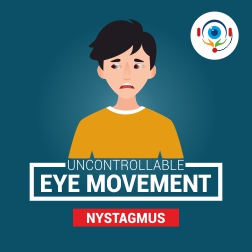Nystagmus
Disease
The brain and inner ears are responsible for the normal functioning of eye movements. So when they fail to operate, the eyes begin to move fast and uncontrollably and lead to an eye condition called Nystagmus.
Eyes that are affected by nystagmus move up and down, in a circular motion or side-by-side, and affect either one or both the eyes.
Nystagmus may affect balance and coordination.
However, children who have nystagmus can have normal vision with absolute normal functioning.
There are different forms of nystagmus -
1. Congenital Nystagmus - Also known as Infantile Nystagmus, this type of nystagmus appears in the first two to three months after birth. In this, the child's eyes move together or oscillate (swing like a pendulum). Congenital nystagmus is linked to other conditions like congenital absence of the iris, congenital cataract, underdeveloped optic nerves and albinism.
2. Spasmus Nutans - This takes place between 6 months to 3 years after a child is born. Children who have this kind of nystagmus usually nod and tilt their heads and their eyes may move in any direction. It improves on its own between the ages of 2 and 8, and often does not require any treatment.
3. Acquired Nystagmus - Develops at a later time in childhood or adulthood. This may be caused due to use of drugs or alcohol, central nervous system and metabolic disorders.
Causes
Neurological problem that is present at birth or develops in early childhood is a common cause of congenital nystagmus. Acquired nystagmus is often a symptom of another disease or condition (multiple sclerosis or trauma, strokes).
Following are other factors that cause nystagmus -
1. Congenital Cataracts
2. An Extremely High Refractive Error (nearsighted or astigmatism)
3. Under-developed Normal Eye Movement Control
4. Inner Ear Inflammation
5. Diseases of the Central Nervous System
6. Medications (like anti-epilepsy drugs)
7. Albinism
Diagnosis
Following are ways by which nystagmus can be diagnosed -
1. Medical History - The medical history of the individual will help determine any symptoms, environmental factors that may be a contributing element to the symptoms, presence of any health issues or medications.
2. Visual Acuity Test - To assess the extent to which vision may be affected.
3. Testing the Eyes - To check how the eyes move and work together, and how they focus. This testing will aid in looking for any kind of problems that affect the control of eye movement or make it difficult to use both eyes.
4. Refraction - This helps to determine the suitable lens power that is required to compensate for any existing refractive error (nearsightedness, farsightedness or astigmatism).
Depending on the information from your diagnosis, your doctor will help determine if your child has nystagmus and will advise treatment options accordingly.
Treatment
Eyeglasses and lenses will help improve vision, but will not correct nystagmus. It is also quite helpful to use magnifying devices, increased lighting and large-print books.
Some forms of nystagmus generally improve in childhood. In case another illness or condition is the reason behind the nystagmus, the doctor will treat the underlying cause.
Surgery
Surgery is rarely required, but it can be used to treat nystagmus. With the help of surgery null positions are reduced, head tilting lessens and cosmetic appearance gets an improvement.
Takeaway
If you begin to notice unusual movements of your child's eyes, make sure to get a check-up done. A thorough check-up will help determine whether it is nystagmus.



